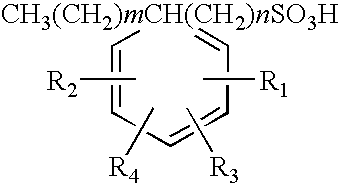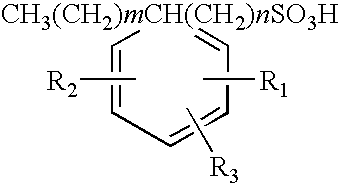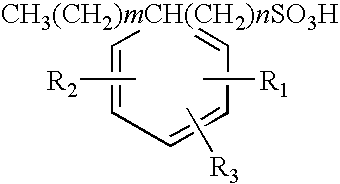Polyalkylated arylalkyl sulfonic acids and their salts
a technology of polyalkylated arylalkyl sulfonic acid and salt, which is applied in the preparation of organic chemistry and sulfonic acid, can solve the problems of excessive foaming in sewage treatment plants, no effective and economical commercially feasible process, and high cos
- Summary
- Abstract
- Description
- Claims
- Application Information
AI Technical Summary
Benefits of technology
Problems solved by technology
Method used
Image
Examples
example 1
[0041]86.2 grams (0.2 Mole) of 1:1 mixture by weight of 1-tetradecanesulfonic acid, (dimethylphenyl)- (common name XSA-14™) and 1-hexadecanesulfonic acid, (dimethylphenyl)- (common Name XSA-16™) was added to a three-necked round bottom flask. XSA-14 and XSA16 are produced by Oil Chem Technologies, Inc. The material was heated to 130° C. at which time 196 grams (0.2) moles of 1-tetradecene were added dropwise over a 1.5 hour period. The material was allowed to react and additional 3.5 hours at 130° C. after which it was analyzed for residual 1-tetradecene by Gas Liquid Chromatography and for anionic activity by CID two-phase titration. Residual tetradecene was found to be 2.4% by weight and anionic activity 97.6% by weight. This material was used to formulate an oil recovery surfactant as described in Example 10 to follow.
example 2
[0042]86.2 grams (0.2 Mole) of 1:1 mixture by weight of 1-tetradecanesulfonic acid, (dimethylphenyl)- and 1-hexadecanesulfonic acid, (dimethylphenyl)- was added to a three necked round bottom flask. The material was heated to 130° C. at which time 32.2 grams (0.2) moles of Neodene™ 1112, a C11-C12 internal olefin produced by Shell Chemical was added dropwise over a 15 minute period. The material was allowed to react and additional 4 hours at 130° C. after which it was analyzed for residual 1-tetradecene by Gas Liquid Chromatography and anionic activity by CID two-phase titration. Residual tetradecene was found to be 1.5% by weight and anionic activity 98.3% by weight.
examples 3-9
[0043]The following examples on Table 2 show the reactants used and yields obtained using the method employed in Examples 1 and 2 for several other reactions carried out with different starting materials included within the scope of the present invention. In the case of propylene, the reaction was carried out under pressure in a 2-liter stainless steel Paar reactor. In all cases equimolar mixtures of the two reactants were used.
[0044]
TABLE 2Polyalkylated Aryl Alkyl Sulfonic Acids Prepared Using the Processof the Present InventionArylalkylAnionicSulfonicReactionReactionResidual Olefin,Activity, % byExample #acidOlefinTemp, ° C.Time, hr% by wtwt1XSA-1416 ™C14 AO13051.297.62XSA-1416 ™C11-12 IO13051.598.33XSA-1416 ™C38020.898.24XSA-14 ™C6 AO12031.198.85XSA-14 ™C12 AO13050.7298.96XSA-16 ™C16 IO13050.7698.17XSA-18 ™C18 AO13062.197.28XSA-2024 ™C12 AO13064.295.19XSA-1416 ™C1416 AO13051.997.9Note:XSA-14 ™: 1-tetradecanesulfonic acid, (dimethylphenyl)-XSA-16 ™: 1-hexadecanesulfonic acid, (dim...
PUM
| Property | Measurement | Unit |
|---|---|---|
| temperatures | aaaaa | aaaaa |
| temperatures | aaaaa | aaaaa |
| temperatures | aaaaa | aaaaa |
Abstract
Description
Claims
Application Information
 Login to View More
Login to View More - R&D Engineer
- R&D Manager
- IP Professional
- Industry Leading Data Capabilities
- Powerful AI technology
- Patent DNA Extraction
Browse by: Latest US Patents, China's latest patents, Technical Efficacy Thesaurus, Application Domain, Technology Topic, Popular Technical Reports.
© 2024 PatSnap. All rights reserved.Legal|Privacy policy|Modern Slavery Act Transparency Statement|Sitemap|About US| Contact US: help@patsnap.com










